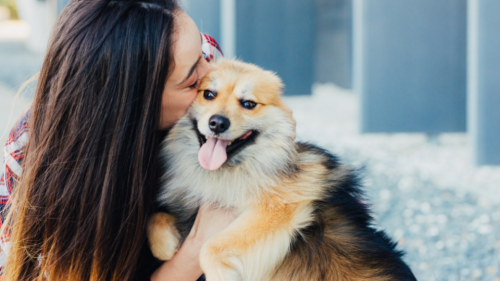
Pet Care Tips
Veterinarian Visits
Responsible pet ownership starts with regular visits to the veterinarian. Given their shorter-than-human lifespan, your dog or cat should be getting a checkup at least once or twice a year. Depending on your pet’s vaccination schedule, they may go more frequently when they’re young, but establishing and maintaining good pet health means keeping up with vet visits as they age.
Trips to the vet can be, shall we say, challenging. Cats, in particular, may be averse to leaving the comfy confines of their home, but there are ways to reduce stress for both of you. Acclimating your cat to her carrier when she is a kitten is good practice (and avoids the running-away-and-hiding-under-the-bed scenario). Dogs tend to like going for car rides. Take your pup on joyrides, so he won’t associate getting into the car with going to the vet. And many pets don’t mind a trip to the veterinarian’s office, especially if you choose a vet that’s a good fit for your little friend.
Vaccinations
Vaccinating your pets is a vital component of responsible pet care. Soon after welcoming your new pet into your home, schedule an immunization appointment. During your first visit, the vet will set up an immunization schedule for your little pup or kitten to protect them from illness and disease. Vaccinations for puppies should happen early in your puppies first few weeks after you bring him home. Talk to your vet at your first appointment, on when a good time to schedule that visit. They help prevent diseases such as rabies, Lyme disease, and distemper. Cats benefit from vaccines that prevent feline herpes virus, feline leukemia, and rabies. If you’ve adopted an adult or senior animal, make sure they are immunized, too. Vaccinations do need renewal and aren’t just for young pets.
Proper Identification
If the unthinkable happens and your little guy or gal gets lost — youngsters in particular are prone to dashing out the door — having proper identification is the key to a happy ending. Start with the basics: a safe collar, and a tag that contains all of your contact information. In addition to an ID tag, microchipping your pet is advisable, because there’s always the chance a collar will fall off. The microchip, an electronic device about the size and shape of a grain of rice, is implanted under your pet’s skin and can be read by a scanner that pulls up your identification information. A combination of these forms of identification will go a long way to reuniting you and your beloved pet, but only if you keep your contact information up-to-date. Be sure to change your information on file with the microchip if you have a change in address or phone number.
Safe Playtime
It’s no secret that dogs and cats love to play, and it’s an effective relationship-building activity. Take stock of their toys. Are they safe? Be mindful of threadbare stuffed toys that pose choking hazards and hard, sharp edges that could cause injury. Throw away and replace playthings that are worn out. Making DIY cat toys and dog toys is a great, inexpensive way to bring even more fun to pet parenting!
Remember, these tips aren’t applicable just during pet holidays — make them part of your regular pet parenting role, and you and your pets will reap the benefits for a lifetime!
Following Dog Park Rules
Taking your dog outside to play is one heck of a good time, and, being the social creatures they are, dogs love a good romp outdoors. If you decide to take your pup to a dog park, abide by the posted rules. Proper dog park etiquette, such as bringing your own toys and not bringing in food, keeps everyone safe, especially if a dog is aggressive or under-socialized. Bring along treats for afterward to reward your guy for his good behavior. Vets also recommend that you wait until your dog is at least four months old before bringing him to the dog park to ensure he’s vaccinated before being exposed to other animals.
Training and Socializing
One of the most important aspects of responsible pet care is ensuring your dog or cat is well-trained, and proper socializing is a part of that. Starting when they’re young is best and most effective, but it’s never too late to learn new tricks. Toilet training is the number one priority for any animal with whom you share your home, as is working on obedience training. Learning socialization skills will help your puppy or kitten bond with you and with other pets. Ask your vet or local animal shelter for recommendations for good trainers in your area or at-home training guides to read. A well-trained pet is a happy pet, and that translates to a happy pet parent.
Comfy Quarters
As the seasons change or you rearrange your living space, take a look around to see that you’re providing your pet with a safe, cozy habitat. Dog bed looking a little flat? Buy your pup a new one. Litter box area not cutting it anymore? Spruce up your kitty’s bathroom with a new box and scoop. This also is a good time to check for potential hazards. Look for exposed cords or wires (young animals find these to be great chew toys), secure safety gates, repair loose windows or screens and remove any plants that are poisonous to your pet.
At-Home Care
As your pets’ caretaker, your job is to provide them with good hygiene habits at home as well as at the vet’s or groomer’s. Brushing their teeth, combing their coats and providing them with healthy food all keeps them in tip-top shape. To stay on track with responsible pet care, schedule hygiene and grooming tasks in your calendar and try combining tasks, such as a comforting comb after trimming nails, until it becomes routine.
Healthy Food
Two connected elements of responsible pet ownership include providing animals with fresh, cool water and healthy food at all times. The right pet food will enrich your best buddy’s life, providing them with the energy and nutrients they need. With so many meal options to choose from, it can be daunting, but you can become adept in no time by familiarizing yourself with important ingredients and how they help your pup or kitty. When choosing the best cat food, look for a good balance of protein, carbs and fats. These are important ingredients for dog food, too, as is plenty of fiber for the digestive system. In addition to healthy ingredients, select a pet food formula that is appropriate for your pet’s age, health conditions and activity level, and speak to your vet before switching your pet to a specialized food.
